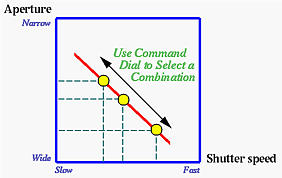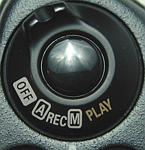
|
| The mode dial |
The Flexible Program mode can only be used in M-REC. However, the flexible program is not a stand-alone mode, it is part of the program mode in M-REC.
In the Program Mode mode, the camera selects both an aperture and shutter speed. Although this reduces the burden of photographers, the selected (aperture, shutter speed) may not be the most suitable one. As a result, the flexible program mode, which is discussed on this page, comes to overcome this problem. Under the flexible program mode, you can pick the most appropriate combination of (aperture, shutter speed) for your need.
To use the flexible program mode, you have to be in M-REC by turning the mode dial as shown below:

|
| The mode dial |
To enter the program mode when you are in M-REC, hold the MODE button (below left) and turn the command dial (below right).
 |
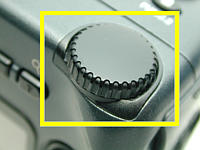 |
| The MODE Button | The Command Dial |
While the command dial is being turned, the letter in the lower-left corner of the control panel and the LCD monitor will change (see the images below). The possible letters are P, A, S and M for the program, aperture-priority, shutter-priority and manual exposure modes, respectively. Therefore, once P appears, the camera is in the program mode and you can release the MODE button.
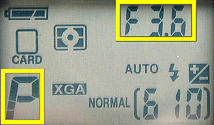
|
| P* for the flexible program mode |
You can use the same procedure to switch to another exposure mode.
To enter the flexible program mode, just turn the command dial. Then, the control panel and LCD monitor will display P*, indicating that the camera is now in the Flexible Program Mode.
When the camera is in the flexible program mode, the lower-left corner of the control panel and the LCD monitor display P*. See images below. On the LCD monitor, next to the letter P* are the shutter speed and aperture selected by the camera.

|
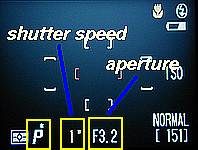
|
| Control Panel | LCD monitor |
The upper left corner of the control panel may display the selected aperture as shown above or the selected shutter speed. You can choose which information to display. To make a selection, pressing the MODE button switches the display from aperture (resp., shutter speed) to shutter speed (resp., aperture).
When you turn the command dial, different combinations of (aperture, shutter speed) appear on the control panel and the LCD monitor. When the appropriate pair appears, stop turning and consequent shots will use this combination until it is modified. Note that if the selected shutter speed is longer than or equal to 1/4 second, it is shown in yellow on the LCD monitor to indicate that noise may appear in the recorded image.
You can also use Exposure Compensation to increase or decrease exposure. Therefore, with this flexible program mode and exposure compensation, we have the advantage of program mode and still can control aperture and/or shutter speed.
As discussed in Exposure Value: EV, when the shutter release button is pressed, the camera meter measures the incoming light and determines an EV (i.e., exposure value). All (aperture, shutter speed) combinations that can achieve the same EV value are on the same EV line. When you turn the command dial, the camera will go through and display these possible (aperture, shutter speed) combinations. When you stop turning the command dial, the current (aperture, shutter speed) is used. This concept is shown in the figure below.
